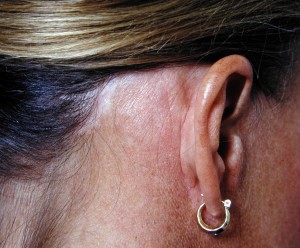Facelifts
While the incision on the back of the ear and into the occipital scalp may be ‘hidden’, how it is made and closed has a lot to do with the improvement one will see in the neck. The length of this hidden incision determines how much neck skin can be pulled up. In a limited facelift, for example, this part of the facelift incision stops just above the earlobe. As a result, very little neck tightening can be achieved. By bringing the incision up along the groove of the back of the ear and fading it into the scalp hair, the neck skin can be freed up behind the ear down into the neck. This allows more redraping upward and serves as an important part of a full facelift.
An important part of this backside facelift incision is how the hairline is managed in the skin redraping process. Some plastic surgeons make the incision not into the occipital hairline but along it, thus avoiding any chance of a hairline step-off. Other plastic surgeons extend the incision horizontally back well into the hairline. How this is closed will determine whether a hairline step-off is seen.
While the facelift incision behind the ear may be well-hidden and ‘only visible by one’s hairstylist’ in some patients, women with shorter hairstyles as well as most men do not have this luxury. In this subset of patients, all with visible postauricular and occipital hairlines, the management of the entire facelift incision is aesthetically critical.
In shorter hairstyles, the incision on the part of the ear must go up higher above the ear hole. Some backcutting of the incision can be done but it should not go very far into the hairline. By modifying the facelift incision in this manner, the amount of neck improvement is lessened but the scar remains more hidden. This is a good trade-off and patients should be appropriately informed of this approach.
Facelift incisions are needed both in front of and behind the ear. The part of the incision in front of the ear has a powerful effect on the jowls and side of the face. The incision on the back part of the ear plays an important role on how much improvement occurs in the neck. Even though it is often hidden, it is equally important to manage the scar behind the ear as well as the one in front.
Dr. Barry Eppley
Indianapolis, Indiana


